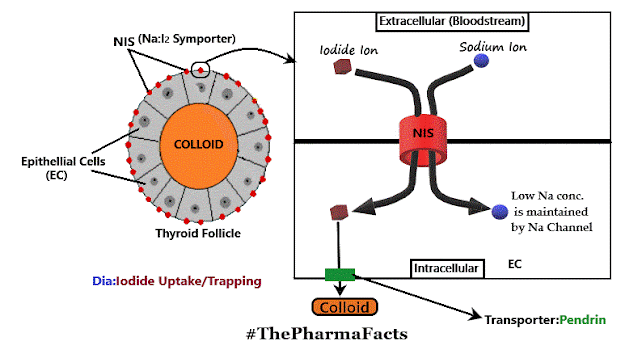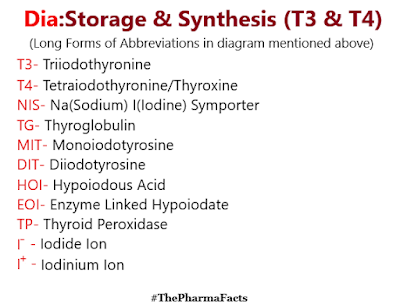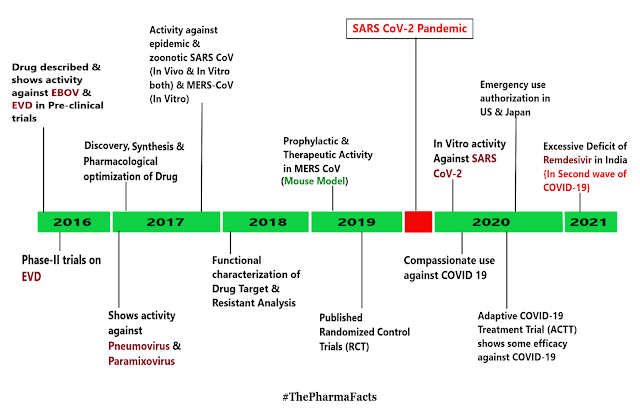Thyroid Hormones [I]
Thyroid Hormones: Analogues & Their Inhibitors
Thyroid gland:
- Location: front of Neck, below the Adam's Apple (larynx).
- butterfly-shaped gland.
- it is composed of Million clusters of follicles.
- a follicle is a structure having epithelial cells surrounding a central mass (colloid).
- Epithelial cells:
(i) follicular cells[T3 & T4]
(ii) parafollicular cells [calcitonin]
- having two lobes; either on the windpipe (trachea).
Thyroid Hormone Actions:
i.Growth & Development
ii.Intermediary metabolism (lipid,carbohydrate & protein metabolism)
iii.Caloriegenesis-production of heat via digestion of food or action of several hormones thus BMR increases
iv.Haemopoiesis
v.Modulate gene transcription
Synthesis, Storage & Release of Thyroid Hormones:
1.Iodine uptake/Trapping:
-total iodine content in body is 30-50 mg out of which ⅕th is present in thyroid
-blood iodine concentration is low i.e. 0.2-0.4 μg/dl
-thyroid cells have active transport process Na+:I2 symporter (NIS) to concentrate sodium ion which is get stimulated by TSH
-there are many locations where this type of transport happens but it is not stimulated by TSH
2.Oxidation & Iodination:
-iodide trapped by follicular cells via NIS is carried across the apical membrane of another transporter termed as Pendrin & then that iodide is oxidised by membrane-bound thyroid peroxidase enzyme to iodinium ions or hypoiodous acid (HOI) or enzyme-linked hypo iodate(E-OI) with the help of hydrogen peroxide
-these all forms of iodine combine with tyrosine residue of thyroglobulin(TG) apparently without any enzyme intervention to form mono-iodotyrosine(MIT) & di-iodotyrosine(DIT)
-these residues are still attached to TG chains
3.Coupling:
-pairs of tyrosine residues couple together to form T3 and T4 (formation of T4 >>> T3)
-but during iodine deficiency relatively more MIT is available and hence more T3 is formed thus, more active hormone(T3) is generated with a lesser amount of iodine
-coupling is an oxidative reaction and is catalyzed by the same enzyme i.e. thyroid peroxidases
-oxidation of iodide and coupling both are stimulated by TSH
- MIT + DIT = T3
- DIT + DIT = T4
4.Storage & Release:
-MIT, DIT, T3, T4 all are attached to TG & stored as colloid till it is taken back into the cells by endocytosis and broken down by lysosomal proteases(as shown in diagram)
-T3 & T4 are released to be secreted, while MIT & DIT residues are deiodinated & thus iodine release is finally reutilized.
-uptake of colloid and proteolysis are stimulated by TSH.
- normal human thyroid secrets 60-90 μg of T4 & 10-30 μg of T3.
5.Peripheral conversion of T4 to T3: (in liver and kidneys)
-about ⅓rd part of total T4 secreted goes in in this process and hence most of the plasma T3 is derived from liver
-target tissues take up T3 except brain and pituitary gland which converts T4 to T3 by their own cell components
-there is always equal amount of active(T3) & inactive(rT3) thyronine in the periphery
-this process is carried out by iodothyronine deiodinase which exist in three forms:(D1, D2, D3)
D1 = produces T3 & rT3
D2 = produces T3
D3 = produces rT3
Transport,Metabolism & Excretion:
-thyroid hormones are mostly bound to plasma proteins
-0.03-0.08% of T4 & 0.2-0.5% of T3 are present in free form
-almost all Protein-Bound Iodine(PBI) in plasma is Thyroid hormone.
-plasma protein binding affinity for T4 (decreasing order) viz:
1) Thyroxine Binding Globulin (TBG)
2) Thyroxine Binding Prealbumin (Transthyretin)
3) Albumin
-Normal concentration of PBI is 4-10 μg/dl where 0.1-0.2 μg/dl is of T3 and rest is T4.
-Only free hormone is available for metabolism, excretion as well as various actions as mentioned before.
-Metabolic inactivation of T3 & T4 occurs by deiodination & glucuronide/sulfate conjugation.
-liver is the primary site for metabolism & excretion processes along with salivary glands(Very rare) and kidneys.
-conjugates excreted as bile of which significant fraction get deconjugated in intestines & reabsorbed in enterohepatic circulation then finally excreted through urine.
-plasma t½ of T4 is 6-7 days & of T3 is 1-2 days.
-half-lives are shortened in hyperthyroidism due to faster metabolism & they get lengthened in hypothyroidism due to relatively slower metabolism.
In next post:Thyroid Hormones [II], the following topics will be covered:
1.Regulation of secretion
2.Relationship between T3 & T4
3.Pharmacokinetics & Interactions
4.Uses
5. Thyroid Inhibitors
So, be in touch folks..!






Comments
Post a Comment
If you have any query or If you like the post,Please let me know.